You’ll find North Galena, South Dakota 11 miles southeast of Deadwood, where prospectors discovered rich galena ore deposits in 1874. This former boomtown peaked at 2,000 residents during the Black Hills Gold Rush, with the arrival of the Burlington Railroad in 1902 marking its height of prosperity. Today, you can explore remnants like the preserved Galena Schoolhouse, historic footbridges over Bear Butte Creek, and the Galena Cemetery on Vinegar Hill – where the spirits of pioneer stories still linger.
Key Takeaways
- North Galena was established in 1874 during the Black Hills Gold Rush but became known for its rich galena ore deposits.
- The town peaked with 1,500-2,000 residents during the mining boom before declining in the late 1800s.
- The Burlington Railroad’s discontinuation in 1912 severely impacted transportation links, accelerating the town’s abandonment.
- The historic Galena Schoolhouse and cemetery with 147 graves remain as preserved remnants of the former mining community.
- Located 11 miles southeast of Deadwood, North Galena is now accessible to visitors despite rough roads and limited services.
The Birth of a Mining Frontier Town
When gold was discovered in the Black Hills in 1874, a wave of illegal prospectors flooded into Dakota Territory, setting the stage for North Galena’s founding.
The 1874 Black Hills gold discovery unleashed a flood of prospectors into Dakota Territory, forever changing the region’s destiny.
You’ll find that these early pioneers faced numerous frontier challenges as they established their claims in 1876, battling harsh conditions while developing mining techniques for the area’s unique geology.
Though they initially sought gold, miners discovered something different: rich veins of galena, a valuable lead and silver ore.
The discovery sparked a rush that transformed a remote meadow near Bear Butte Creek into a bustling frontier settlement.
Within months, you’d have seen a growing community of 1,500 to 2,000 residents building cabins, assay shops, and boarding houses.
James Conzette built the town’s first cabin, setting an example for future development.
The mineral’s distinctive perfect cubic cleavage made it easily identifiable for the prospectors searching the hills.
The last Native Americans departed the area that same year, marking a pivotal shift in the region’s history.
Life in Early Galena’s Heyday
Despite historical accounts suggesting a larger population, North Galena‘s residents during its mid-1870s heyday numbered around 75 people, forming a small but dynamic frontier community.
You’d find daily routines centered around mining operations, with miners heading to claims like Sitting Bull and Florence, while others worked at the assay shop or boarding house. The area was particularly known for its silver ore deposits that drew prospectors to the region.
Community gatherings often revolved around these key aspects of frontier life:
- Catholic church services near the southwestern ravine
- Social events at local boarding houses
- Business dealings at various mining-support establishments
You’d see homes built from available materials, including makeshift doors from old sluice boxes. During the Black Hills Gold Rush, North Galena became a bustling stop along Vanocker Canyon.
The presence of James Conzette’s fortified cabin and diverse residents like Sarah “Aunt Sally” Campbell highlighted both the challenges and unique character of this mining community.
Notable Characters and Pioneer Stories
When you visit North Galena today, you’ll find traces of remarkable pioneers like Sarah “Aunt Sally” Campbell, a former slave who became the first non-Native woman in the Black Hills and established her own ranch near town.
You can still see James Conzette’s 1876 cabin, built as a defensive fort with its distinctive sluice box door, though it never saw the Native American raids he feared.
Among the town’s more unusual residents was Tootsie, a friendly coyote who became a beloved local mascot during Galena’s bustling mining days.
The town reached its peak prosperity when the Deadwood Central Railroad arrived in 1902, connecting local mines to broader markets.
Wild West Settlers’ Legacy
Among the rugged pioneers who shaped North Galena’s early history, Thomas Walsh stands out as one of its most notable residents.
Before making his fortune at Colorado’s Camp Bird Mine, Walsh embodied the settler experience of pursuing mineral wealth in the Black Hills.
The community’s resilience during the 1870s settlement period is reflected in three key developments:
- James Conzette’s cabin construction, originally planned as a fort, symbolizing settlers’ determination to establish permanent roots.
- The rapid growth of essential businesses, including an assay shop and boarding house, demonstrating pioneer ingenuity.
- The diverse mix of mining families who created a tight-knit community, sharing technical knowledge and supporting each other through boom-and-bust cycles.
Colonel John H. Davey invested heavily in the area, constructing the Davey Smelter in 1883 before legal troubles forced his departure.
These early settlers’ legacy lives on in the preserved structures and stories that still captivate visitors today.
The town’s final remnants include the historic Vinegar Hill Cemetery, where graves dating back to the 1800s tell silent stories of the mining era.
Aunt Sally’s Lasting Impact
The pioneer stories of North Galena wouldn’t be complete without acknowledging Sarah “Aunt Sally” Campbell, the first non-Native American woman to enter the Black Hills during the 1874 Custer Expedition.
Born into slavery in Kentucky, she’d later become one of Galena’s most influential early residents, demonstrating remarkable pioneer spirit through her varied entrepreneurial ventures.
You’ll find Aunt Sally’s contributions woven throughout Galena’s history – from her work as a cook and prospector during the Custer Expedition to her later roles as a midwife and businesswoman.
She filed mining claims at Elk Creek, owned property during the gold rush, and supported the community through its peak population of 2,000 residents. Her Alice Lode silver mine proved profitable and sold for five hundred dollars before her death.
Her grave at Vinegar Hill Cemetery, marked in 1934, stands as a tribute to her enduring legacy in Black Hills frontier history. She regularly entertained locals by sharing colorful stories about the expedition while smoking her pipe.
Tootsie the Town Coyote
South Dakota’s most famous coyote, Tootsie, emerged as a legendary figure among the colorful characters of North Galena’s frontier days.
You’ll find Tootsie’s Tales woven into the fabric of this ghost town’s heritage, representing the untamed spirit of the Black Hills during the mining era. The coyote’s presence among prospectors and merchants exemplifies the delicate balance between wilderness and civilization that defined frontier life. Like many ghost town hunting expeditions, discovering Tootsie’s story requires patience and careful research through historical records.
Tootsie’s enduring legacy includes:
- Recognition as one of Galena’s “quality ghosts” alongside human pioneers
- Symbolic representation of survival and adaptation in harsh frontier conditions
- Cultural significance in modern heritage events and self-guided tours
Through Coyote Symbolism, Tootsie connects you to authentic pioneer experiences, enriching North Galena’s historical narrative and drawing modern visitors into its wild frontier past.
Mining Operations and Economic Impact

Initially sparked by illegal prospectors searching for gold in 1874, North Galena’s mining operations quickly shifted focus when rich deposits of galena ore were discovered near Bear Butte Creek in 1875.
Within a year, the area transformed into a bustling mining camp as claims were filed and wooden cabins sprang up.
Mining technology evolved rapidly, with the installation of quartz crushing mills, Blake Crushers, and Bolthoff Ball Pulverizers to process the silver-rich galena ore.
By 1886, eight mining companies were actively extracting ore at the peak of operations.
Economic fluctuations marked the town’s trajectory, with the 1902 arrival of the Burlington Railroad boosting growth, while later challenges like claim disputes and transportation issues led to decline.
The 1940s saw a brief revival under Gilt Edge Mines, though operations never reached their former glory.
The Town’s Gradual Decline
North Galena’s decline began well before its final demise, stemming from a complex web of challenges that emerged in the late 1800s. You’ll find that economic downturns hit the town particularly hard, exacerbated by its remote location in the Black Hills gulch.
The town’s fate was sealed by three crucial factors:
- The Burlington and Missouri River Railroad’s discontinuation in 1912, severing essential transportation links
- Harsh environmental conditions that made sustaining infrastructure nearly impossible
- Limited access to necessary services like healthcare and education, driving families away
Poor road conditions and transportation challenges further isolated North Galena from neighboring communities, making trade increasingly difficult.
While the town’s social scene remained vibrant for a time, with establishments like saloons continuing to operate, the population gradually dwindled as residents sought opportunities elsewhere.
What Remains Today

When you visit North Galena today, you’ll find the iconic Galena Schoolhouse still standing as one of the town’s best-preserved historic structures.
The surrounding alpine landscape features original footbridges spanning Bear Butte Creek, offering glimpses into the town’s mining-era infrastructure.
Though many buildings have disappeared over time, the remaining foundations, ruins, and cemetery markers continue to tell the story of this Black Hills settlement, which maintains a small population of year-round residents.
Preserved Historic Structures
Remnants of Galena’s mining heyday stand as silent witnesses to its bustling past, with several historic structures still dotting the landscape of this former boomtown.
Through dedicated preservation techniques by the Galena Historical Society, you’ll find remarkable buildings that have maintained their structural integrity since the 1870s.
Among the most significant preserved structures, you’ll discover:
- Thomas Francis Walsh’s cabin, once home to the prospector who later struck it rich at Colorado’s Camp Bird Mine
- The historic Galena School, which earned a spot on the National Register of Historic Places
- Several original residential buildings and community structures, including former stores and merchant buildings
These authentic remnants offer you a genuine glimpse into the untamed spirit of the American West’s mining era.
Cemetery and Footbridge
Atop Vinegar Hill stands the historic Galena Cemetery, a poignant reminder of the town’s mining legacy containing up to 147 known graves.
You’ll discover Civil War veterans, Sarah Campbell who cooked for Custer’s expedition, and numerous miners among those interred here. The cemetery’s historical significance is evident in its diverse markers, from weathered headstones to simple crosses and iron rails dating to the 1880s.
To access this preserved piece of history, you’ll need to hike up the abandoned railroad bed.
While exploring, you’ll notice over 30 depressions marking lost graves, which dedicated volunteers continue to identify and re-mark.
The cemetery preservation efforts, led by local historians Mark and Suzanne Luken, guarantee this essential connection to Galena’s past endures for future generations.
Planning Your Ghost Town Visit
Planning a visit to North Galena requires careful consideration of its remote Black Hills location, 11 miles southeast of Deadwood.
Located deep in the Black Hills, North Galena’s remote setting demands thoughtful trip planning for visitors exploring this historic site.
You’ll want to prepare thoroughly for the rugged terrain and limited services in this historic mining town.
For ideal visitor preparation and safety, remember these essential points:
- Base yourself in nearby Deadwood or Lead for accommodations and services, as Galena offers no modern amenities.
- Pack weather-appropriate gear and extra supplies, as South Dakota weather can change rapidly.
- Bring a reliable vehicle suitable for rough roads, and don’t count on cell service.
Time your visit for the second Saturday in June to experience the town’s annual celebration featuring local food and bluegrass music.
You’ll find excellent photography opportunities among the historic structures and Bear Butte Creek’s scenic surroundings.
Frequently Asked Questions
Are There Any Reported Ghost Sightings or Paranormal Activity in Galena?
You’ll find ghostly legends about prospectors, saloon keepers, and schoolmarms haunting Vinegar Hill Cemetery and historic buildings, though paranormal investigations haven’t produced concrete evidence beyond visitor accounts and local folklore.
Can Visitors Legally Take Artifacts or Minerals Found at the Site?
You’ll want to keep your hands in your pockets – artifact preservation laws and legal regulations strictly prohibit removing any items from Galena. Taking artifacts or minerals risks hefty fines and prosecution.
What Wildlife Encounters Should Visitors Be Prepared for in the Area?
You’ll likely encounter deer, coyotes, and various raptors. For wildlife safety, maintain distance from any prairie rattlesnakes near rocks. Watch for bison, pronghorn, and elk during dawn/dusk animal sightings.
Is Camping Allowed Within the Ghost Town Boundaries?
While 90% of ghost towns allow dispersed camping, you can’t camp within North Galena’s boundaries due to camping regulations protecting historical significance. You’ll need to camp at least 300 feet away.
Are Metal Detectors Permitted When Exploring the Galena Ghost Town?
You can’t use metal detectors without written authorization and permits from South Dakota Game, Fish and Parks. Metal detecting regulations strictly control treasure hunting tips, requiring proper permissions and limiting digging activities.
References
- https://www.legendsofamerica.com/galena-south-dakota/
- https://www.southdakotamagazine.com/galenas-ghosts
- https://en.wikipedia.org/wiki/Galena
- https://www.blackhillsbadlands.com/blog/post/old-west-legends-mines-ghost-towns-route-reimagined/
- https://mad-peak.com/blog-posts-and-info/f/galena-south-dakota-adventure-into-a-wild-west-ghost-town
- https://www.youtube.com/watch?v=2zGg23yeB5w
- https://www.blackhillshikingbikingandmore.com/the-town-of-galena
- https://sidneygoldrushdays.org/history-black-hills-gold/
- https://www.mininghistoryassociation.org/NorthernHillsTour3.htm
- https://www.sdpb.org/shows/south-dakota-documentaries/special/galena-the-ghost-town-that-refuses-to-die-v6gw2a



